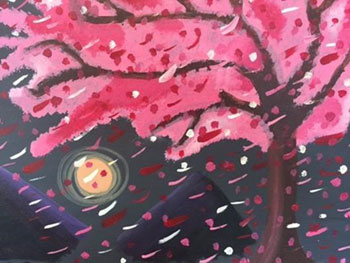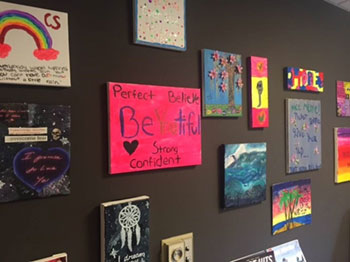Imagine leaving your job and family, picking up everything to move hundreds of miles away to enter treatment for your mental illness or addiction. You’ve been searching for months for a program that can help and for what feels like the hundredth time, a doctor tells you that you are in the right place. Do you believe it? Maybe not—but what if you heard from someone who has actually been there?
Across Rogers Behavioral Health, many prospective patients and families do. Some say there’s something more honest and encouraging about reassurance from someone that has experienced similar struggles and has been in the very program they are about to enter.
Handprints and marks of healing
At Rogers Behavioral Health–Nashville, all patients participate in a ‘”discharge circle” upon discharge from their program. The patient’s family, treatment team and fellow patients talk about the progress that person has made, provide encouraging words and more as they move into lower levels of care or out of programming.
“At the end of that circle, patients paint their hands, put their handprint on the wall of our experiential therapy room and write a quote next to their handprint,” says Kathryn Boyer, experiential therapist at Rogers–Nashville. “The handprint says ‘I was here and I made it through this’ and the quote provides inspiration for future patients.” Each is as individualized as the person who left it, but many have a common theme of finding peace with imperfection.
Staff members in Nashville first started the project for patients with obsessive-compulsive disorder (OCD) and contamination anxiety, who, at the end of programming, would be able to paint their hands, give high-fives and avoid over-washing throughout the day. “When they first came to us, they were washing their hands up to 30 times per day, 15 minutes per time. Seeing them be able to do this upon discharge is amazing,” says Boyer.
Several patients have told Boyer the wall provides encouragement to get through programming, especially when first arriving for treatment. “New patients see the discharge circle and all the support that comes from everyone involved in the treatment process, and it’s been very beneficial.”
The large display of handprints is also inspirational for staff. “Some days can be difficult, but it always helps when I go into the experiential therapy room, think about the stories behind each handprint. I’ve learned so much from them,” says Boyer.
Child and adult patients at Rogers Behavioral Health Hospital–Brown Deer contribute to a similar project displaying painted handprints, semicolons and other marks as a sign of overcoming mental health challenges and completing treatment.
Letters and pictures of encouragement
Patients and loved ones of patients in Nashville also write letters of encouragement to future patients and families. “For patients, it feels like they’ve left something here,” says Boyer. “The greatest benefit I’ve seen is for parents whose children are entering treatment. When they see that patients have written something that talks about their progress, it gives them peace of mind.”
Children enrolled in Rogers Behavioral Health–Tampa Bay’s eating disorder partial hospital program and OCD and anxiety partial hospital and intensive outpatient programs , as well as Rogers Behavioral Health–Chicago’s child and adult programs also write letters to future patients. “In Tampa, we keep a book of letters in our office and share it with children and their parents as they begin acclimating to programming,” says Katie Merricks, behavioral specialist at Rogers–Tampa Bay.
But parents aren’t the only family members who benefit from the experience. “Many parents take a copy of their letter home to share with family members, friends and others in their lives so they too can understand what this process has been like,” says Merricks. “We’ve had siblings and grandparents write letters as well, so you really get many perspectives on the treatment process when reading the book.”
Sometimes, young patients choose to draw their personal reflections instead of writing. “The youngest person we’ve had make a letter was an eight-year-old, and it was mainly a drawing and a thank you,” says Merricks. “The handwritten letters and drawings are so much more personal.”
Merricks explains there’s something special about receiving encouragement from a former patient. “We can tell them, as clinicians, that they’re not alone and our treatment is great. But seeing a testimony from someone who’s shared a similar journey and struggles makes them feel so much more comfortable with trusting our care,” she says. “We have parents who pick up and move with their child across the country, leaving little ones and loved ones behind. The letters provide confirmation that they’re making the right decision.”
Canvasses to celebrate

In Nashotah, a residential dialectical behavior therapy (DBT) program for high school girls with emotional dysregulation at Rogers Behavioral Health–Oconomowoc, patients create their own graduation canvases which are displayed in the program’s community space. “The visual personal statements of their recovery journeys which the girls paint inspire others to complete the program,” says Lisa Herpolsheimer, manager of Nashotah.
As in Nashville, inspirational quotes play an important role in the project in Nashotah. “They often write a quote that is meaningful to them from the dialectical behavior therapy (DBT) skills and philosophy, such as learning to accept themselves as they are fully and at the same time learning to change and grow,” she says. “Seeing peers finish their canvases makes the other girls look forward to painting their own.”
Herpolsheimer explains that seeing the canvasses also helps newcomers because, though the program can be challenging, it is manageable and they can be successful. “New patients relate well to the realness of the other girls as they see similar interests based on what their paintings represent,” she says. “The girls also look forward to seeing what their peers may choose to paint. Admiring the finished canvas is a way to celebrate recovery.”


